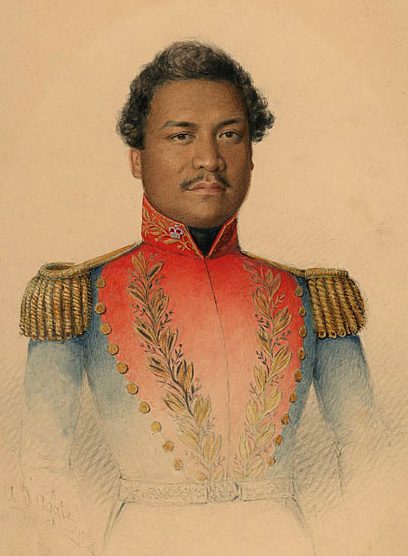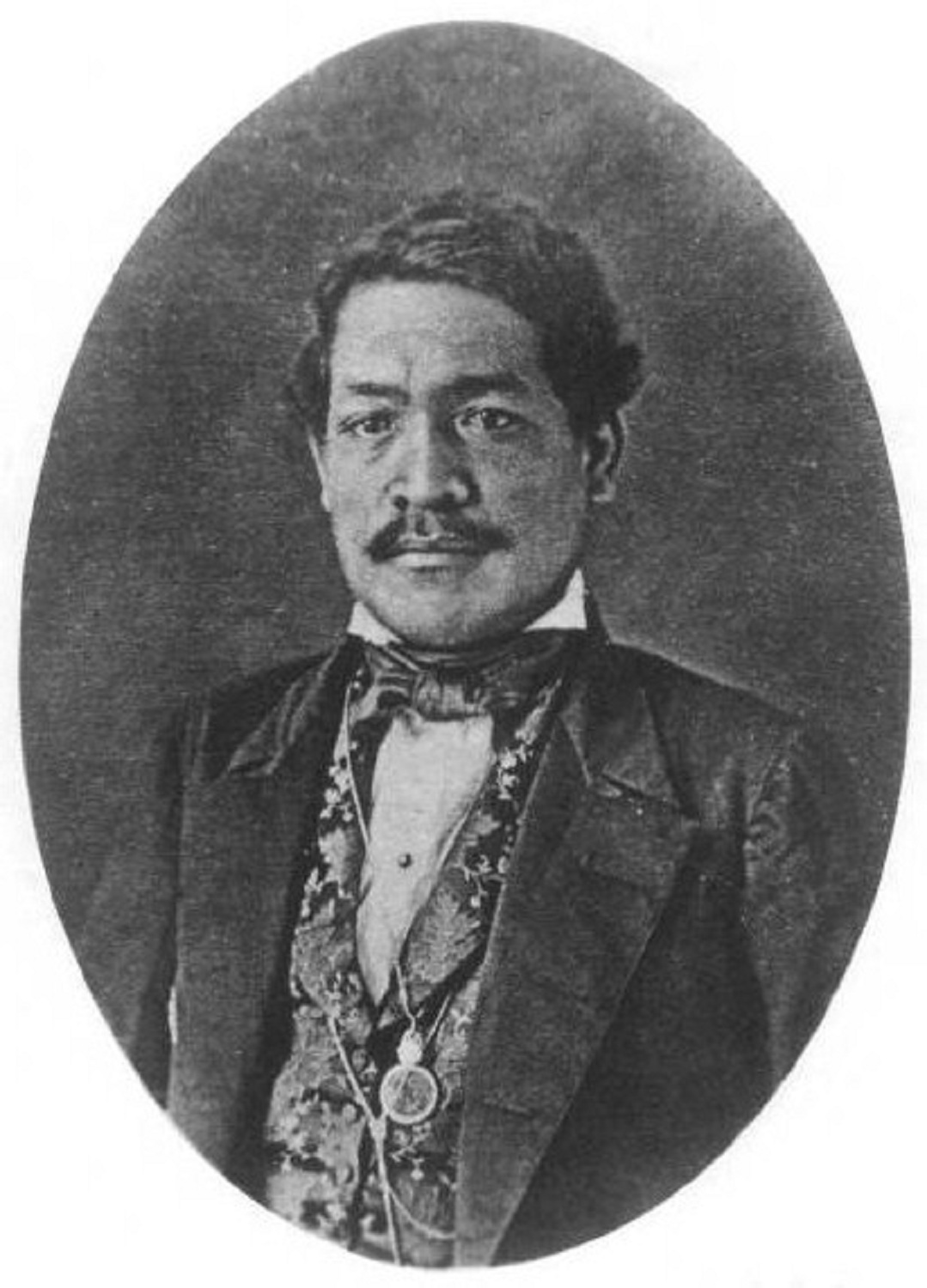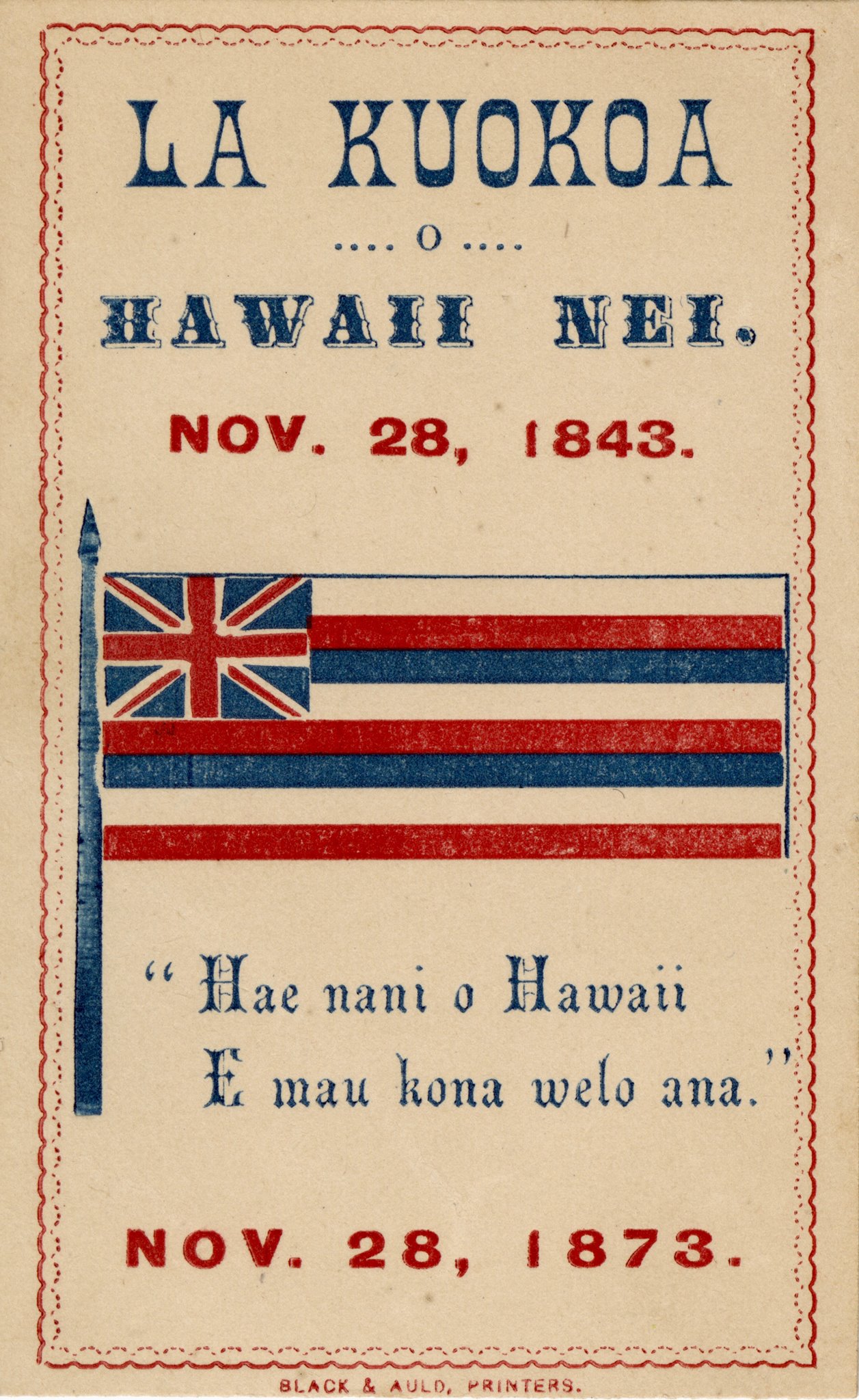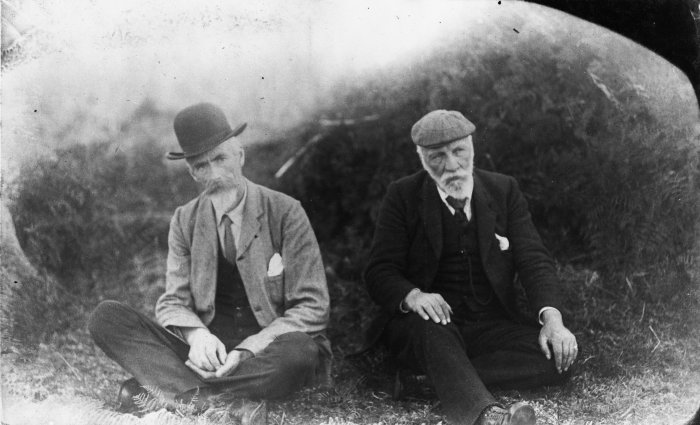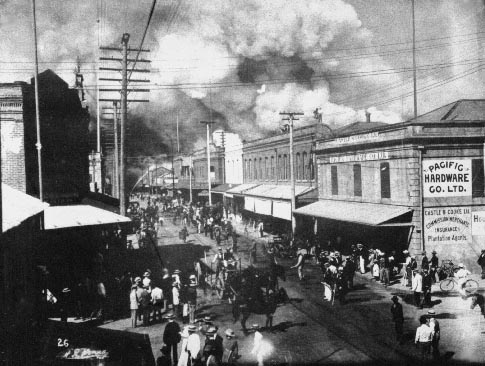|
KamehamehaВ III
Kamehameha III (born Kauikeaouli) (March 17, 1814 – December 15, 1854) was the third king of the Hawaiian Kingdom, Kingdom of Hawaii from 1825 to 1854. His full Hawaiian name was Keaweaweula Kīwalaō Kauikeaouli Kaleiopapa and then lengthened to Keaweaweula Kīwalaō Kauikeaouli Kaleiopapa Kalani Waiakua Kalanikau Iokikilo Kīwalaō i ke kapu Kamehameha when he ascended the throne. Under his reign, Hawaii evolved from an absolute monarchy to a constitutional monarchy with the signing of both the 1840 Constitution of the Hawaiian Kingdom, 1840 Constitution, which was the first Hawaiian Language Constitution, and the 1852 Constitution of the Hawaiian Kingdom, 1852 Constitution. He was the List of longest-reigning monarchs, longest reigning monarch in the history of the Kingdom, ruling for 29 years and 192 days, although in the early part of his reign he was under a regent, regency by Kaʻahumanu, Queen Kaahumanu and later by Kīnaʻu, Kaahumanu II. His goal was the careful bala ... [...More Info...] [...Related Items...] OR: [Wikipedia] [Google] [Baidu] |
Kingdom Of Hawaii
The Hawaiian Kingdom, also known as the Kingdom of HawaiК»i (Hawaiian language, Hawaiian: [kЙ› ЙђwЛ€puni hЙ™Л€vЙђjК”i]), was an Archipelagic state, archipelagic country from 1795 to 1893, which eventually encompassed all of the inhabited Hawaiian Islands. It was established in 1795 when Kamehameha I, then AliК»i nui of Hawaii, conquered the islands of OК»ahu, Maui, MolokaК»i, and LДЃnaК»i, and unified them under one government. In 1810, the Hawaiian Islands were fully unified when the islands of KauaК»i and NiК»ihau voluntarily joined the Hawaiian Kingdom. Two major Dynasty, dynastic families ruled the kingdom, the House of Kamehameha and the House of KalДЃkaua. The kingdom subsequently gained diplomatic recognition from European powers and the United States. An influx of European and American explorers, traders, and whalers soon began arriving to the kingdom, introducing diseases such as syphilis, tuberculosis, smallpox, and measles, leading to the rapid decline of the Native H ... [...More Info...] [...Related Items...] OR: [Wikipedia] [Google] [Baidu] |
KeЕЌpЕ«olani
Kalanikauikaalaneo Kai Keōpūolani-Ahu-i-Kekai-Makuahine-a-Kama-Kalani-Kau-i-Kealaneo (1778–1823) was a queen consort of Hawaii and the highest ranking wife of King Kamehameha I. Early life Keōpuolani was born around 1778 at an area known as Pahoehoe of Pāpōhaku, near present-day Wailuku, on the island of Maui. She was known as Kalanikauikaalaneo in her early childhood. Her name means "Gathering of the Clouds of Heaven". Her father was Kīwalaʻō, King of Hawaii island. He was the son of King Kalaniʻōpuʻu of Hawaii island who met Captain James Cook at Kealakekua Bay. Her mother was Queen Kekuiapoiwa Liliha, half-sister of Kamehameha I. Their father was Keōuakupuapāikalani. Kiwalaō and Kekuiapoiwa Liliha were half-siblings through their shared mother, High Chiefess Kalola-Pupuka-Honokawahilani of Maui. As a child, Keōpuolani lived for a while in Hāna (the eastern tip of Maui), then moved back to the Wailuku area. Battle of Kepaniwai In 1790, while Keōp ... [...More Info...] [...Related Items...] OR: [Wikipedia] [Google] [Baidu] |
1852 Constitution Of The Hawaiian Kingdom
The 1852 Constitution of the Hawaiian Kingdom, written in both English and Hawaiian, was constructed by King Kamehameha III. The purpose of its construction was to not only revise, but add to the 1840 Constitution in great length. The new constitution created a more democratic government much like those of the United States and Europe. King Kamehameha III The writer of the Hawaiian Constitution of 1852 was Kauikeaouli, referred to by the Hawaiian public as King Kamehameha III. He was the successor of Liholiho, King Kamehameha II. Kauikeaouli was the brother of Liholio and son of Kamehameha I. Kauikeaouli took over the throne at age eleven under the "regency" of his mother Ka'ahumanu. Kauikeaouli enacted the first constitution of Hawaii in 1840 which created a more western-like government with a two-body legislature. This was later revised in 1852. King Kamehameha III was the first Hawaiian monarch to rule as a "constitutional monarch" rather than an absolute monarch like his prede ... [...More Info...] [...Related Items...] OR: [Wikipedia] [Google] [Baidu] |
1840 Constitution Of The Hawaiian Kingdom
The 1840 Constitution of the Hawaiian Kingdom titled was the first fully written constitution for the Hawaiian Kingdom. Overall, this version of the Constitution of Hawaii established a constitutional monarchy subjecting even the king to certain principles of democracy. Background The need for a constitution was originally intended as a manner of laws set forth to control the Native Hawaiian population with a Western style and legal framework, giving less severe punishments, such as being exiled, than was the traditional custom until the 1840s. Christianity had failed to change many behaviors of the Hawaiian population, even with the support of the families. Adultery and many other sexual relations became forbidden. Hawaiians were arrested and sentenced to severe punishments that were not well organised. The exiled had little food and could easily swim away from the islands and the prison at Honolulu Fort. The issue became worse as fewer pardons from the were available, and t ... [...More Info...] [...Related Items...] OR: [Wikipedia] [Google] [Baidu] |
Constitutional Monarchy
Constitutional monarchy, also known as limited monarchy, parliamentary monarchy or democratic monarchy, is a form of monarchy in which the monarch exercises their authority in accordance with a constitution and is not alone in making decisions. Constitutional monarchies differ from absolute monarchies (in which a monarch is the only decision-maker) in that they are bound to exercise powers and authorities within limits prescribed by an established legal framework. A constitutional monarch in a parliamentary democracy is a hereditary symbolic head of state (who may be an emperor, king or queen, prince or grand duke) who mainly performs representative and civic roles but does not exercise executive or policy-making power. Constitutional monarchies range from countries such as Liechtenstein, Monaco, Morocco, Jordan, Kuwait, Bahrain and Bhutan, where the constitution grants substantial discretionary powers to the sovereign, to countries such as the United Kingdom and other Com ... [...More Info...] [...Related Items...] OR: [Wikipedia] [Google] [Baidu] |
Hawaiian Kingdom
The Hawaiian Kingdom, also known as the Kingdom of HawaiК»i ( Hawaiian: Й› ЙђwЛ€puni hЙ™Л€vЙђjК”i, was an archipelagic country from 1795 to 1893, which eventually encompassed all of the inhabited Hawaiian Islands. It was established in 1795 when Kamehameha I, then AliК»i nui of Hawaii, conquered the islands of OК»ahu, Maui, MolokaК»i, and LДЃnaК»i, and unified them under one government. In 1810, the Hawaiian Islands were fully unified when the islands of KauaК»i and NiК»ihau voluntarily joined the Hawaiian Kingdom. Two major dynastic families ruled the kingdom, the House of Kamehameha and the House of KalДЃkaua. The kingdom subsequently gained diplomatic recognition from European powers and the United States. An influx of European and American explorers, traders, and whalers soon began arriving to the kingdom, introducing diseases such as syphilis, tuberculosis, smallpox, and measles, leading to the rapid decline of the Native Hawaiian population. In 1887, King KalДЃ ... [...More Info...] [...Related Items...] OR: [Wikipedia] [Google] [Baidu] |
Mauna Ala
{{disambig ...
Mauna or Mouna may refer to: * ''Mauna'' (moth), genus of moths in the family Geometridae * Mauna (silence), silence in Hindu philosophy ** Maun Vrata, term for a vow of silence in India * Mauna, Käbschütztal, village in Käbschütztal, Germany * A Hawaiian word for mountain, used in the following Hawaiian volcano names: ** Mauna Loa, on Hawai'i ** Mauna Kea, on Hawai'i ** Mauna Ulu, cinder cone of Kīlauea, on Hawai'i ** Mauna Iki, cinder cone of Kīlauea, on Hawai'i ** Mauna Haleakalā, on Maui ** Mauna Hina, cinder cone of Haleakalā See also *Maun (other) *Mouna Ragam (other) ''Mouna Ragam'' is a 1986 Indian film. ''Mouna Ragam'' (alternatively ''Mounaragam'', ''Mounaraagam'' or ''Mouna Raagam''; ) may also refer to these in Indian entertainment: * ''Mouna Ragam'' (soundtrack), of the 1986 film * ''Mouna Raagam'' (Ta ... [...More Info...] [...Related Items...] OR: [Wikipedia] [Google] [Baidu] |
Polynesian Society
The Polynesian Society is a non-profit organisation based at the University of Auckland, New Zealand, dedicated to the scholarly study of the history, ethnography and mythology of Oceania. History The society was co-founded in 1892 by Percy Smith and Edward Tregear, largely in response to a conviction widely held at the time, that the MДЃori and other Polynesian peoples were a dying race. Smith and his friends hoped that it would help to preserve the traditional lore of the MДЃori before it disappeared and provide scholars with a forum for learned discussion of their ethnographic research (Byrnes 2006). The initial membership of the society was 112, which had grown to 1,300 by 1965. Presidents have included bishops H. W. and W. L. Williams; James Pope, Edward Tregear, Percy Smith, Elsdon Best, William Skinner, Sir ДЂpirana Ngata, Harry Skinner, J. M. McEwen, Professor Sir Hugh Kawharu and Dame Joan Metge. The present president is Dr Richard Benton. Until her death in ... [...More Info...] [...Related Items...] OR: [Wikipedia] [Google] [Baidu] |
Oahu
Oahu (, , sometimes written Oahu) is the third-largest and most populated island of the Hawaiian Islands and of the U.S. state of Hawaii. The state capital, Honolulu, is on Oahu's southeast coast. The island of Oahu and the uninhabited Northwestern Hawaiian Islands constitute the City and County of Honolulu, Hawaii, City and County of Honolulu. In 2021, Oahu had a population of 995,638, up from 953,207 in 2010 (approximately 70% of the total 1,455,271 population of the Hawaiian Islands, with approximately 81% of those living in or near the Honolulu urban area). Oahu is long and across. Its shoreline is long. Including small associated islands such as Ford Island plus those in KДЃneohe Bay and off the eastern (windward and leeward, windward) coast, its area is , making it the List of islands of the United States by area, 20th-largest island in the United States. Well-known features of Oahu include WaikД«kД«, Pearl Harbor, Diamond Head, Hawaii, Diamond Head, Hanauma Bay, KДЃn ... [...More Info...] [...Related Items...] OR: [Wikipedia] [Google] [Baidu] |
Honolulu
Honolulu ( ; ) is the List of capitals in the United States, capital and most populous city of the U.S. state of Hawaii, located in the Pacific Ocean. It is the county seat of the Consolidated city-county, consolidated City and County of Honolulu County, Hawaii, Honolulu, situated along the southeast coast of the island of Oahu, OК»ahu, and is the westernmost and southernmost major U.S. city as well as westernmost and southernmost U.S. state capital. It is also a major hub for business, finance, hospitality, and military defense in both the state and Oceania. The city is characterized by a mix of various Asian culture, Asian, Western culture, Western, and Oceanian culture, Pacific cultures, reflected in its diverse demography, cuisine, and traditions. is Hawaiian language, Hawaiian for "sheltered harbor" or "calm port"; its old name, , roughly encompasses the area from NuК»uanu Avenue to Alakea Street and from Hotel Street to Queen Street, which is the heart of the present dow ... [...More Info...] [...Related Items...] OR: [Wikipedia] [Google] [Baidu] |
К»Iolani Palace
The Iolani Palace () was the royal residence of the rulers of the Kingdom of HawaiК»i beginning with Kamehameha III under the Kamehameha Dynasty (1845) and ending with Queen LiliК»uokalani (1893) under the KalДЃkaua Dynasty. It is located in the capitol district of downtown Honolulu in the U.S. state of Hawaii. It is now a National Historic Landmark listed on the National Register of Historic Places. After the monarchy was overthrown in 1893, the building was used as the capitol building for the Provisional Government, Republic, Territory, and State of Hawaii until 1969. The palace was restored and opened to the public as a museum in 1978. К»Iolani Palace is the only royal palace on US soil. Early history Pohukaina and the House of Kamehameha In the early 19th century, the site of К»Iolani Palace was near an ancient burial site known as Pohukaina. It is believed to be the name of a chief (sometimes spelled Pahukaina) who according to legend chose a cave in Kanehoalani ... [...More Info...] [...Related Items...] OR: [Wikipedia] [Google] [Baidu] |
